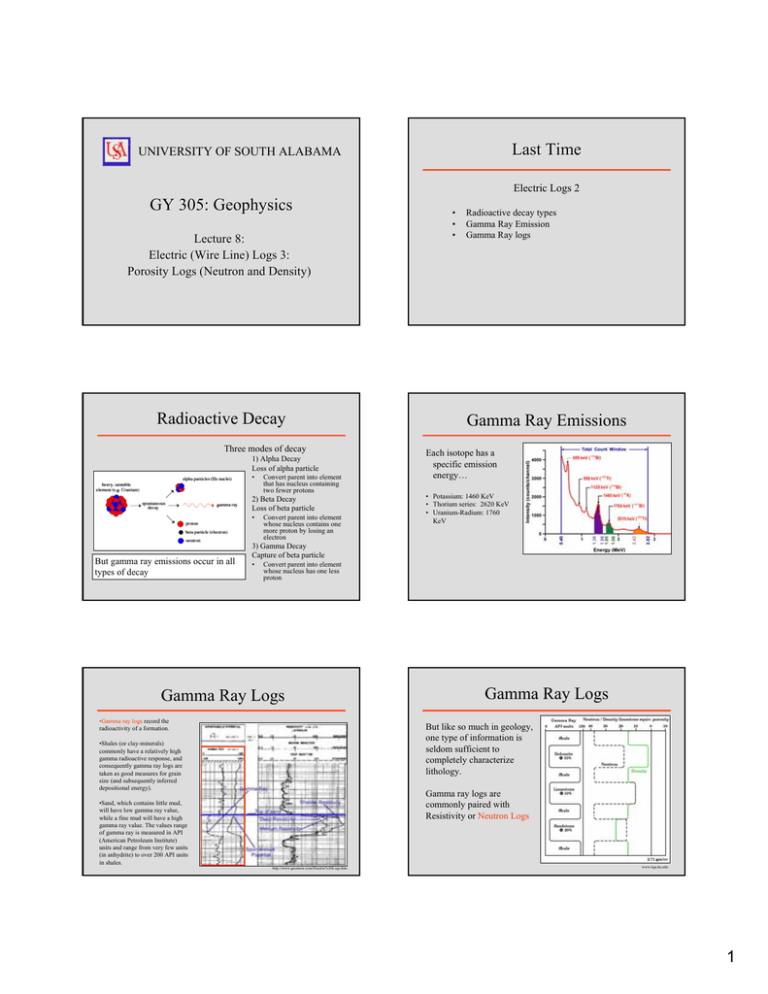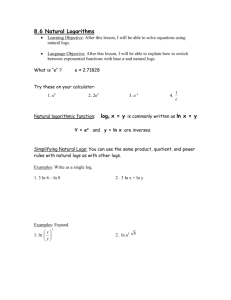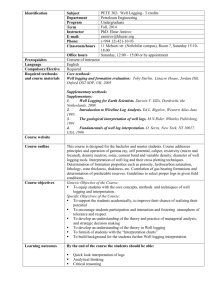Last Time GY 305: Geophysics Radioactive Decay Gamma Ray Emissions
advertisement

Last Time UNIVERSITY OF SOUTH ALABAMA Electric Logs 2 GY 305: Geophysics Lecture 8: Electric (Wire Line) Logs 3: Porosity Logs (Neutron and Density) Radioactive Decay Three modes of decay 1) Alpha Decay Loss of alpha particle • Convert parent into element that has nucleus containing two fewer protons 2) Beta Decay Loss of beta particle • But gamma ray emissions occur in all types of decay Convert parent into element whose nucleus contains one more proton by losing an electron • • • Radioactive decay types Gamma Ray Emission Gamma Ray logs Gamma Ray Emissions Each isotope has a specific emission energy… • Potassium: 1460 KeV • Thorium series: 2620 KeV • Uranium-Radium: 1760 KeV 3) Gamma Decay Capture of beta particle • Convert parent into element whose nucleus has one less proton Gamma Ray Logs •Gamma ray logs record the radioactivity of a formation. Gamma Ray Logs But like so much in geology, one type of information is seldom sufficient to completely characterize lithology. •Shales (or clay-minerals) commonly have a relatively high gamma radioactive response, and consequently gamma ray logs are taken as good measures for grain size (and subsequently inferred depositional energy). Gamma ray logs are commonly paired with Resistivity or Neutron Logs •Sand, which contains little mud, will have low gamma ray value, while a fine mud will have a high gamma ray value. The values range of gamma ray is measured in API (American Petroleum Institute) units and range from very few units (in anhydrite) to over 200 API units in shales. http://www.geomore.com/Electric%20Logs.htm www.kgs.ku.edu 1 Porosity Today’s Agenda Electric Logs 3 • • • One of the most important parameters in petroleum geology and one of the hardest to directly measure (especially in limestones) Porosity Logs Neutron Logs Density Logs Note: Resistivity can sometimes do it, but this log is ultimately controlled by water salinity 1 mm Plan polarized light http://www.spec2000.net/07-eslog.htm Porosity Logs Neutron Logs Neutron Logs have a radioactive source (tritium?) that generates neutrons. As they pass into the rock, they lose energy (especially if they hit nuclei of similar weight (e.g., hydrogen). A term applied to 3 basic log types: 1) Neutron 2) Density 3) Sonic (next time) http://www.spwla.org/library_info/glossary/reference/glossd/images/glsp33f1.gif Neutron Logs Neutron Logs ...Neutron Logs also distinguish hydrogen concentration. Neutron Logs use shallow penetration (6”) and mostly see mud filtrate, but... http://www.spwla.org/library_info/glossary/reference/glossd/images/glsp33f1.gif The more H, the more adsorption. http://www.spwla.org/library_info/glossary/reference/glossd/images/glsp33f1.gif 2 Neutron Logs Neutron Logs ...Neutron Logs also distinguish hydrogen concentration. ...The more hydrogen you detect, the more porosity you have The more H, the more adsorption. Notes: 1) Shales absorb neutrons because of high (bound) water content 2) Water and oil have similar H content and thus, similar neutron absorptions 3) gas has very low H content 4) coal shows enormous absorption of neutrons High counts=low adsorption (Low porosity) Low counts=high adsorption (high porosity) http://www.spwla.org/library_info/glossary/reference/glossd/images/glsp33f1.gif Neutron Logs http://www.spwla.org/library_info/glossary/reference/glossd/images/glsp33f1.gif Neutron Logs •Neutron logs measure the porosity of a formation, indicating in its response the quantity of hydrogen present in the formation. •The log is calibrated to limestone. •Neutron logs can be used to resolve lithology (usually in combination with Density Log). •The linear limestone porosity units are calibrated using the API Neutron pit in 19% porosity, waterfilled limestone is defined as 1000 API units. Chalk Board http://www.geomore.com/images/new%20pa8.jpg Density Logs http://www.geomore.com/images/new%20pa8.jpg Density Logs Use a gamma ray source attached to a skid plate •gamma rays interact with electrons clouds of atoms, •the gamma ray “flux” decreases with increasing numbers of electrons in the formation adjacent to the emitter far detector CH 100: electrons = protons (Z) Atomic number (A) = protons+neutrons near detector http://www.freepatentsonline.com/6738720.html 3 Density Logs Density Logs •gamma rays interact with electrons clouds of atoms, •the gamma ray “flux” decreases with increasing numbers of electrons in the formation adjacent to the emitter •The Density log is a measure of the formation's bulk density and is mostly used as a porosity measure. CH 100: electrons = protons (Z) Atomic number (A) = protons+neutrons if you assume Z/A = 0.5, then you can then estimate apparent formation density Reported in g/cm3 or kg/m3 http://www.resolve-geo.com/geophysical/index_clip_image004.jpg Density Logs Neutron and Density Logs •The Density log is a measure of the formation's bulk density and is mostly used as a porosity measure. •Different lithologies can also be determined using Density log based on returned density value. For example, pure quartz will have a bulk density (g/cm3) up to 2.65, coal 1.2-1.8, halite 2.05, limestone up to 2.75, dolomite up to 2.87, anhydrite 2.98. http://energy.cr.usgs.gov/OF00-200/WELLS/SBAR20/LAS/SB20LOG.JPG Chalk board http://www.resolve-geo.com/geophysical/index_clip_image004.jpg Logs used in Combination Upcoming Stuff Thursday Lab: SP Correlations Due at 2:00 PM Gamma Ray Correlations issued •The “crossover” effect as a gas indicator Next Monday Lecture “Midterm” exam (Haywick’s part) •CNL: Neutron Log •FDC: Density Log http://www.geo.wvu.edu/~jtoro/Petroleum/Review%203.html 4



